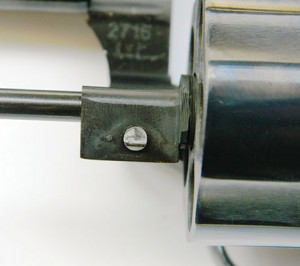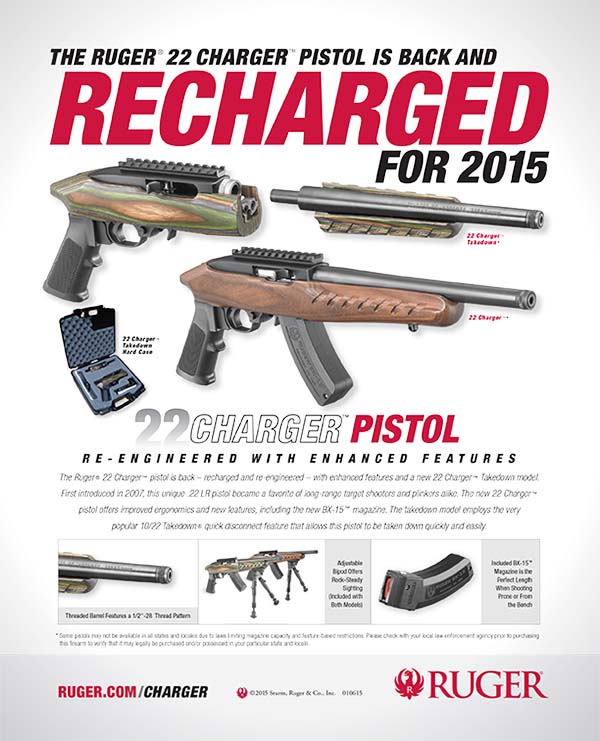by R.K. Cambell | Contributing Editor
My favorite dog is the Boston terrier. Pugnacious, full of character and compact, they are unique animals. They are not for everyone. By the same token my daily carry guns are not for everyone, but they are among the best suited to the defense role of any handgun.
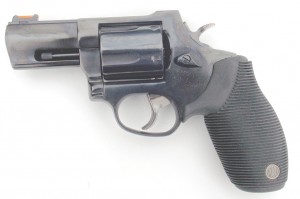
The Taurus-manufactured Rossi R441 just may raise the base line in revolvers. It is fast from leather, smooth in operation, and hits hard.
After 40 years of carrying a handgun and finding myself in the wrong place at the wrong time more than once I know a little about interpersonal combat. Despite the proliferation of “carry guns” with target features, defense pistols are a breed apart from target guns. Tactical pistols are great for entry teams and soldiers, but my CZ 75 B rail gun isn’t the best choice for daily carry. My choices are based upon solid selection and historical reference. From the time shooters began to downsize the Colt revolver into a lighter handgun, the handgun has evolved into a close quarter defensive tool. The Colt Navy and the various shortened versions including the Police versions and the Colt SAA Sheriff’s Model answered the need for a compact and powerful handgun that could be presented quickly but concealed under a reasonably light garment. That is the mission statement. Personal defense was the goal. The long barrel Colt SAA, designed to knock down an Indian war pony at 100 yards, was not the gun for the task.
The Fitz Special and other powerful handguns were among the finer defensive revolvers of the day. Self-loaders were slower in coming. There were lighter concealable self-loaders such as the Colt 1903, true, but they were chambered for ineffectual calibers. The Colt Commander .45 was the first self loader that was both light and powerful.
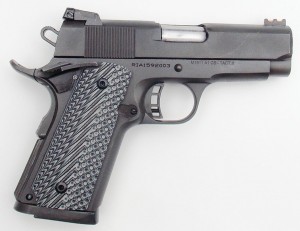
The author has found the Rock Island 1911 handgun serviceable from the beginning. The latest version raises the bar in quality. With excellent adjustable sights, VZ G 10 grips, improved controls and good quality control you get a lot of 1911 for a modest price with the RIA Tactical II.
At this point I think I need to make an important distinction in what I consider a short barrel revolver and a snub-nose revolver. The short barrel revolver is a service handgun with a short barrel. A Model 19 Combat Magnum or a Model 27 .357 with a 2½ to 3½-inch barrel is a short barrel revolver. The five-shot Chief’s Special is a snub-nose. That keeps my mind straight in choosing handguns. The snub-nose is a hideout that is moderately useful. The short barrel full size handgun is far more useful. As for self-loaders the Commander is only ¾ inch shorter than the Government Model. It is difficult to consider the Commander a compact. When the Commander is also a steel frame variant it certainly isn’t a compact. The Officer’s Model, with its 3½-inch barrel and shorter frame, is a true compact in my estimation.
The lead up is that short, powerful handguns have been sought after by those going in harm’s way for over 100 years. Today we have short, powerful handguns that are the finest ever produced and the best personal defense handguns that are available. Yet, many shooters tend to approach the problem and concern for self-defense with a delusional attitude. A hope and a prayer are good but careful study is also indicated. The recent popularity of the .380 ACP is a puzzling phenomenon. They are light and handy and a very few are reliable. But they are not enough for personal defense. The .38 Special +P and 9mm +P are little enough. Anyone recommending a .32 or .380 for personal defense isn’t doing the student any favors and does not have any experience in personal combat. A far better solution is a big bore handgun, a .44 revolver or a .45 automatic. Too large and heavy? Hardly. They are ideal for personal defense.
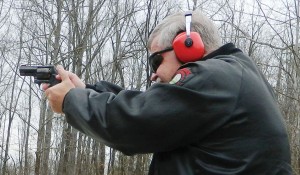
The author enjoyed firing the Taurus-built Rossi R441 with a variety of loads. The Ribber grips absorb recoil well and the revolver’s smooth action allows rapid hits.
This brings us to another subject. You do not need a handgun that will cut a two-inch group at 25 yards. A quick six-inch group at 7 yards will save your life. The proper tool must be fast into action, reliable, and hit hard. As any boxer will tell you, a single heavy blow always trumps several light blows. A .45 or so in the X-ring beats a cluster of 9mm holes. The question might be: if we saw off the grip handle and barrel, reducing sight radius, energy and controllability, what do we gain? The answer is we gain a lot.
A handgun with a shorter grip conceals well. With a short barrel the handgun may be concealed readily in a high riding holster. Concealed carry is the goal, but another advantage is realized. These short handguns are fast from the holster. A shorter handgun clears leather more quickly and gets on target quickly. The short sight radius lines up quickly at close range. There is less travel in the draw. Shoot the elbow to the rear, scoop the piece from the holster and you are on target. What I like about my carry guns is that very little is compromised. The little guns are reliable, which isn’t always true of shortened handguns. There is no practical compromise in power, as the big bore cartridges are not dependent upon barrel length for effect. Practical accuracy as far as hitting the target at moderate range is good. They are not as accurate in a practical sense as larger handguns but they do not need to be. They are surprisingly accurate, however, in trained hands. Too often I see shooters that practice on the range with a .45 auto or .357 revolver, then carry a compact 9mm or snub nose .38. They are talking the talk but not walking the walk. These handguns let you do both.
The Revolver
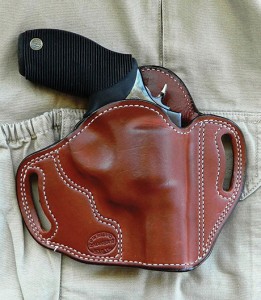
This D.M. Bullard holster is first class, serviceable, and with the correct balance of speed and retention for the Rossi R441.
A short-barrel revolver with a full size grip is very fast from leather. Among the advantages of the revolver is simplicity. Draw and fire. Another advantage is that the revolver may be thrust into the adversary’s body and fired repeatedly. The K-frame revolver is about the ideal size for all around use. When the K-frame is a five shot .44, things get interesting. The Rossi R441 is a study in company branding. Taurus purchased Rossi some years ago. The Rossi 720 .44 Special is out of production. The new R441, marked “made by Taurus” is a fixed sight version of the Taurus Tracker. The Tracker line is proven and durable and often very accurate. The action is smooth and the yoke detent, once a custom option, gives the action rigidity. The five-shot cylinder is chambered for the .44 Magnum cartridge. This is OK as far as it goes and may prove useful with moderate loads for animal defense. Against our protein-fed ex-con criminal class and feral dogs the .44 Special is plenty. The R441 features a well-designed rear sight. Unlike the simple trough in most revolvers this rear sight is raised from the frame in the manner of the Webley MK 2 revolver. The front sight features a red fiber optic insert. About 1921, Tom Threepersons had a raised front sight, square and tall, fabricated and fitted to his single action army and the first high-visibility handgun sight (to my knowledge) was born. The R441 carries on well.
Perhaps the best feature of the R441 is the Ribber grips. They are soft, a little sticky, with excellent adhesion. At no point does the hand contact the frame when you are firing this revolver. While the .44 Special isn’t a hard kicker these grips keep things in control and comfortable. This handgun is carried in a D M Bullard “Combat Holster.” David is a fine young craftsman with a well-designed product. The Combat holster exhibits an excellent balance of speed and retention. The holster rides high and may be concealed beneath a short covering jacket. The R441, with its snubby two inch barrel, clears leather quickly.
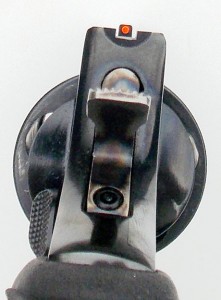
The author is willing to make a bold statement: these are the best combat revolver sights he has ever used.
For practice, I often use the Black Hills Ammunition .44 Special. This 210-grain load breaks about 700 fps from the R441. In double-action fire control is excellent. With the smooth double-action trigger and bright insert front sight, simply place the sight on the target and you have a hit at 7 yards. The cadence of fire with a revolver is fire, reset, fire, reset, with the same amount of time involved in reset as the trigger press. When firing at the range I feel that it is a better test of marksmanship to fire at small targets at known and unknown ranges. The R441 is up to the task at ranges well past 25 yards.
The .44 Special is a mild-mannered big bore that is easy to control. While the .455 Webley, with a 265-grain bullet at 650 fps, gained a good reputation in the field, this seems a tad slow for personal defense. The Speer Gold Dot 200-grain JHP bumps the .44 Special up to 775 fps. This load offers a good balance of penetration and expansion. Blazer aluminum-case loads are available at a fair price. No, it isn’t a Magnum but it is a good performer. The Hornady Critical Defense is another good choice, with bullet technology designed to perform well at modest velocity. The hottest load for the R441 is the CorBon DPX at 885 fps. This 200-grain all copper bullet is a solid choice well worth the price.The Cor Bon load isn’t a hard kicker but you know it is something special. As for recoil the R441 is more pleasant to fire than any .38 Special snub-nose revolver. With the heavier .44 Special load it is in .38 +P category as far as recoil. I would much rather have this revolver than a six-shot .38. As for the .357 Magnum, well, I have the greatest respect for the Magnum. But the blast, flash and recoil are not something I seek after. The R441 is a credible revolver that will handle 99% of defensive problems for those that practice.
The flat gun
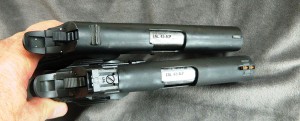
There is a big difference in sighting equipment between the GI gun and the Tactical II. The Tactical II is worth its price.
Some of us like a flat concealable handgun. While I like the R441 a great deal, sometimes a revolver on the hip looks like the water moccasin that swallowed a possum. The 1911 is flat. Even the long heavy Government Model is flat. The Commander is shorter. The Officer’s Model is ideal for concealed carry. It is interesting that the Rock Island Arms (RIA) Tactical II has much in common with the R441 revolver. A great deal of thought went into the sights. The rear sight is fully adjustable. While I have not been a fan of adjustable sights on combat guns, the RIA .45 is accurate enough to make use of these sights and they seem rugged. Coupled with a fiber optic red front sight, the sight picture is excellent for combat use. The rear sight operates differently from most. To lower the sight the spring loaded leaf is pressed downward as the screw is turned down. There is a significant difference between the point of impact and point of aim with different weight bullets in the short .45 automatic. Even without the adjustable component, the sight picture is excellent. Also in common with the R441, this light .45 automatic features among the best designed grip panels ever fitted to a light handgun. The VZ Grips G10 panels are ideal for adhesion and help control recoil and maintain a non-slip surface. The RIA .45 is a good feeling handgun with the right balance. The frame is steel, and in this rendition it comes off well.
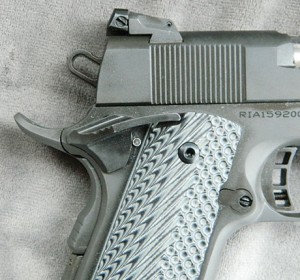
Note the well-designed upswept ambidextrous safety. This is one of the best designs the author has examined. It isn’t likely to work loose as it is stabilized by an elongated sear pin. A groove in the sear pin allows the safety to ride in the sear pin.
The Rock Island came out of the box running with a single break in malfunction. This was a failure to extract. If you do not like break-in malfunctions then the revolver, not the semi-auto, is for you. After the first fifty rounds the pistol has functioned without fail. The RIA Tactical II handles differently from the Government Model, but handles well. The flat short grip is a little slower on the draw and the flat automatic is pinned closer to the body than the revolver, so the pistol is a little slower. However, rapid repeat hits are much quicker. Recoil isn’t excessive with standard pressure loads. The Speer 230-grain Gold Dot is controllable, accurate, and offers good performance. The Hornady 185-grain Critical Defense is a credible choice. Shot placement carries the day but these loads give the advantage of reliable expansion. The compact .45 demands a quality inside-the-waistband holster. I chose a custom IWB from a bright young talent. He learned from one of the best. Jason Winnie is Don Hume’s grandson. His leatherwork is earning well deserved recognition. The RIA pistol rides well in this holster.
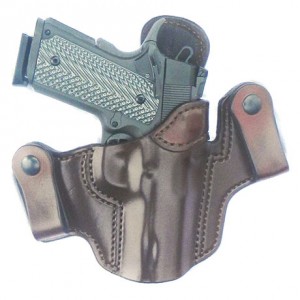
The Jason Winnie inside the waistband holster is ideal for the short, flat and handy Rock Island Compact Tactical II.
The Rock Island Tactical II .45 is a neat gun, well proportioned, and surprisingly accurate. I like this handgun a lot. However- on any Tuesday when you have a cold, or are laying on the dressing table, the Rossi R441 looks good. On the other hand why not simply purchase both? The Rock Island Tactical and the Rossi R441 may be had for the price of a single mid-grade 1911 from the major makers. That is something to write about.

